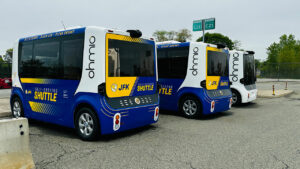With Manila’s international airport set to undergo improvements starting this September, I wonder if the planned upgrade will include autonomous transport — driverless vehicles to move around staff, crew, passengers, cargo, supplies. The airport has four terminals. It needs to find an efficient way to move around people and goods in its vast compound.
Autonomous or automated transport lowers labor costs and mitigates labor-related issues. It can also result in higher productivity and efficiency. While capital investment in equipment and systems is high at the start, operating cost can be lower in the long run. If done right, and with proper safety systems in place, autonomous transport can also minimize accidents.
These are all hypothetical, of course. No system is totally error-free. Mistakes and accidents can still occur. But there are lessons to be learned from New York, Tokyo, Singapore, and many other airports around the world that have all embarked on autonomous or driverless transport systems, either for staff, luggage, or passengers — either as mass transit or for personal mobility.
In July, it was reported that New York’s John F. Kennedy International Airport started using self-driving shuttle buses to transport passengers from parking lots to the AirTrain terminals. The shuttles, which carry eight passengers each, run a route that is 1.5 miles long. The shuttles do not have drivers. But they have “safety attendants” that can manually drive them when needed.
In Tokyo, The Japan Times reported that Haneda Airport was testing “a driverless vehicle” that can tow up to 13 metric tons of cargo containers. The autonomous transport can pull six containers at a time between aircraft and airport buildings for over two kilometers, said the Times. The system is jointly developed by All Nippon Airways (ANA) and Toyota Industries.
In Singapore, The Star reported that a self-driving bus would transport workers around Changi Airport’s restricted area by the third quarter of 2024, under a two-year proof of concept. The autonomous buses are to be used airside, or the part of the airport where the loading and unloading of aircraft, as well as take-offs and landings, take place, The Star said.
Also to be tested at Changi is the use of self-driving buses in “a live operational environment alongside non-autonomous vehicles,” The Star said. It added that there were about 2,500 airside vehicles at Changi at present, which include cars, vans, minibuses, tractors, and forklifts. Driverless baggage tractors and baggage handling vehicles are undergoing testing to date.
The Star noted that at the Hong Kong International Airport, a driverless shuttle bus service has been transporting staff around the airport’s restricted area. It also reported that driverless shuttles will soon be transporting people between Hong Kong Port and SkyCity, a business and entertainment complex adjacent to the airport.
Also in Hong Kong, the South China Morning Post reported that the Hong Kong government contracted a consortium to plan and design a new railway line in East Kowloon that will most likely run driverless trains. The estimated length of the proposed railway is about seven kilometers. It would link eight stations from Choi Hung East to Yau Tong East.
Meanwhile, the use of autonomous transport at the Miami International Airport (MIA) and the Los Angeles International Airport (LAX) is a little different. A company called WHILL, in collaboration with Envoy Air, deploys self-driving wheelchairs that allow passengers with disabilities to get to their boarding gates on their own.
And at the Phoenix Sky Harbor International Airport, a company called Waymo provides fully autonomous ride-hailing services between the airport and downtown. The driverless car service runs 24 hours, and uses all-electric Jaguar I-PACE vehicles. The services run to and from the airport and downtown Phoenix and the East Valley.
In Hawaii, the Daniel K. Inouye International Airport in Honolulu has reportedly started an 18-month autonomous shuttle pilot program to transport airport staff within the airport’s restricted areas. Four autonomous and electric shuttles that can transport 11 passengers, including a shuttle attendant, between the airport’s C and G Gates with several stops.
Over at Heathrow Airport in the UK, it uses driverless pod cars that transport passengers between Terminal 5 and the business car park. According to airport authorities, these pods are energy-efficient and provide a smooth, on-demand ride for passengers. They also help reduce congestion by eliminating approximately 50,000 bus journeys annually. Heathrow is also testing autonomous baggage dollies at Terminal 5.
With all these ongoing testing programs in various airports all over the world, and given the long timeline for the Manila airport’s upgrading, perhaps in about three years’ time driverless shuttles will also be moving about the Philippine airport compound. With four terminals in operation, driverless shuttles might make more sense instead of an airport monorail.
Inevitably, there will be safety concerns. To date, no major errors or accidents have been reported involving driverless airport shuttles and cargo handling transport. But the potential for technical failure will always be a concern, as with anything automated. Continuous monitoring and improvements can help ensure that driverless transport operates without accidents.
More important, people will have to learn to be comfortable with autonomous transport. Otherwise, acceptance and effective use may be compromised. One research study notes the importance of calibrating public trust so that airport staff and passengers can feel safe and confident using new technologies like driverless transport.
Marvin Tort is a former managing editor of BusinessWorld, and a former chairman of the Philippine Press Council
